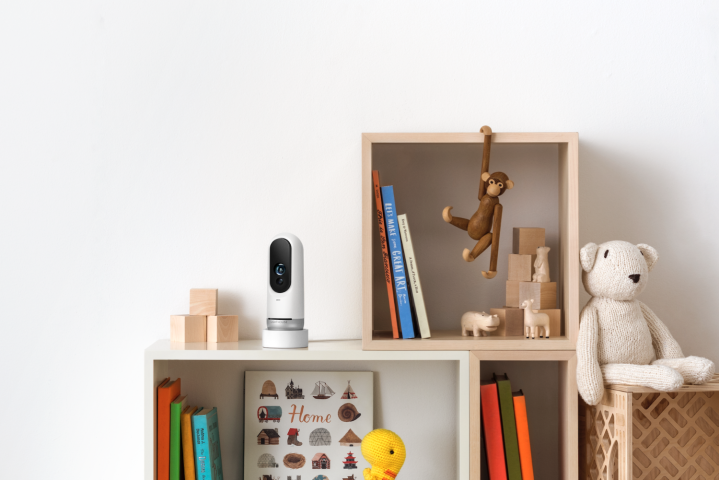
If you have a DIY, Wi-Fi-enabled home security camera and a pet, there is a good chance you’ve turned off the notifications. How many times can Grover the dog stroll passed the camera before you stop checking to reassure yourself it’s not a burglar? False alarms are a big problem with security cameras, and a new device called Lighthouse may have solved them — just don’t call it a security camera. The system is now available for purchase.
“It is an interactive assistant for your home. You tell it what things you care about, and it tells you when those things happen,” Alex Teichman, CEO and co-founder of Lighthouse, told Digital Trends. Not only does it use 3D-sensing and machine learning to distinguish between people and pets while discounting moving shadows and swaying branches, it makes searching through your footage incredibly easy. Just ask, via the app, “What did my kids do this afternoon?” or “Did the dog walker show up today?” and you’ll see the relevant events. You can also ask for notifications when the dog walker arrives, so you don’t have to hunt for the footage.
“I know that everything happened that was supposed to happen without a million phone calls,” said Jessica Gilmartin, the company’s general manager and CMO.
The Lighthouse itself has a microphone, speaker, and 100-decibel siren. In addition to its 3D sensor, it has an RGB color camera and night vision. It looks a bit like a non-hollow Dyson fan.
“The real magic in this device, it’s in the 3D-sensing,” Teichman said. Each figure, be it a cat or a kid, will show up in your footage ringed in a halo. If the child hugs the cat, they’ll merge into a single halo and the camera will momentarily recognize them as one object. Then they’ll go back to their separate colored outlines. The idea for the camera came from Teichman and co-founder Hendrik Dahlkamp, who both have backgrounds in self-driving-car technology. “When you have a 3D-sensor that sees the structure of the environment, it makes it very easy to see where objects start and end, and that’s a core building block here,” said Teichman.
During a demo, Teichman and Gilmartin used a variety of commands to bring up footage from the Lighthouse in Gilmartin’s home. The requests weren’t always worded in the same way; she asked to see clips from when her husband was “gone” and “not there.” A former IBM Watson engineer worked on ensuring users’ language didn’t have to be super precise. The facial recognition capability wasn’t available for us to see in the demo, but it will be when the device ships in September.
Certain gestures and movements will also be recognized. If your significant other waves to the camera, you’ll get a notification, and you can immediately respond with the “talk” button in the app. If your cat is always jumping on the counter, you can ask to get a notification when that happens. You can try yelling at your cat to get down, but there’s no guarantee that will work. Eventually, you might be able to have the Lighthouse automatically respond to the waver or cat without having to push a button. “That’s where we see the future, the ability for Lighthouse to take action on your behalf,” Gilmartin said. It can’t yet recognize if a person falls or call you if that happens, but the team thinks it will be able to in the future.
While Gilmartin said security is a small part of what the Lighthouse can do, she said it will nonetheless be a very accurate one that doesn’t send alerts when your kids or the dog runs by (unless you want it to). “Because we don’t get triggered on any of those things, when you get a security alert it’s genuinely an unknown person in your home,” she said.
These are all big promises, and the voice control, robust notification options, facial recognition, and 3D-sensing mean you will be paying more than you would for, say, a $199 Nest Camera. There also isn’t a DIY option. $299 gets you a camera and a 90-day free trial of the artificial intelligence service plan, and after that expires, the service becomes $10 a month. Otherwise, if you pay a one-time service fee of $200, you can do away with monthly payments, and just hand over $499 for the Lighthouse and lifetime service.
While the Lighthouse was initially slated to launch last September, this proved to be an unattainable goal. The good news is that as of Thursday, February 22, Lighthouse is available to the general public.
“It’s been an incredible journey thus far, thanks to the tireless efforts of our outstanding team as well as invaluable feedback from early customers,” Teichman wrote in a blog post. “I wanted to use this milestone to reflect on the unique moment we’re in, how far we’ve come — and how excited we are for what’s next.”
Updated on February 22: Lighthouse has now launched with a slightly less expensive price.
Editors' Recommendations
- Should you buy a new smart lock or retrofit your existing deadbolt?
- Blink Mini 2 vs. Wyze Cam v4: Which is the better budget security camera?
- Ring is launching its first integrated pan-tilt security camera later this year
- Blink Mini 2 vs. Ring Stick Up Cam Pro: Which is the best security camera?
- Does the Pan-Tilt Mount work with the Blink Mini 2?


